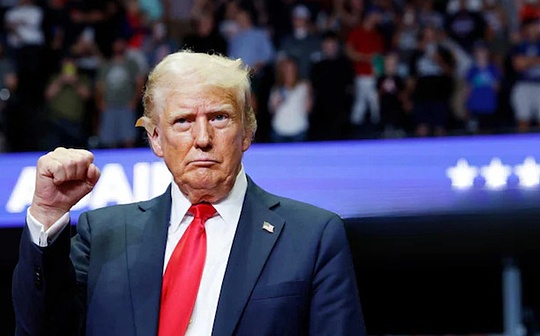Buy coins, new wealth code for listed companies in the US stock market

Reprinted from chaincatcher
05/31/2025·4DAuthor: Shenchao TechFlow
On May 27, a small stock that was unknown caused a huge wave in the trading hall of Nasdaq.
SharpLink Gaming (SBET), a small bookmaker with a market capitalization of only $10 million, announced that it has bought about 163,000 Ethereum (ETH) through a $425 million private equity investment.
As soon as the news came out, SharpLink's stock price soared, with an increase of more than 500%.

Buying coins may be becoming the new wealth code for US **listed
companies to pull stock prices.**
The source of the story is naturally MicroStrategy (MicroStrategy, now renamed Strategy, stock code MSTR), the company that pioneered the war and boldly bet on Bitcoin as early as 2020.
In five years, it has transformed from an ordinary technology company to a "pioneer in Bitcoin investment." In 2020, MicroStrategy's stock price was only over $10; by 2025, the stock had soared to $370, with a market value of $100 billion.
Buying coins not only makes MicroStrategy's balance sheet expand, but also makes it a darling in the capital market.
In 2025, the craze became increasingly fierce.
From technology companies to retail giants to small gambling companies, U.S. listed companies are igniting new engines of valuation with cryptocurrencies.
What are the tricks in the wealth code that makes the market value bigger by buying coins?
MicroStrategy, textbook on how to play coins and stocks
It all starts with MicroStrategy.
In 2020, the enterprise software company took the lead in launching a wave of buying coins in the US stock market. CEO Michael Saylor once said that Bitcoin is a "more reliable asset to maintain value than the US dollar";
The recharge belief is wonderful, but what really makes this company stand out is its way of playing in the capital market.
MicroStrategy's gameplay can be summarized using the combination of "convertible bonds + Bitcoin":
First, the company raises funds by issuing low-interest convertible bonds.
Since 2020, MicroStrategy has issued such bonds many times, with interest rates as low as 0%, far below the market average. For example, in November 2024, it issued $2.6 billion in convertible bonds with almost zero financing costs.
These bonds allow investors to convert to company stocks at a fixed price in the future, which is equivalent to giving investors a call option while allowing the company to obtain cash at an extremely low cost.
Secondly, MicroStrategy will invest all the funds raised in Bitcoin. Through multiple rounds of financing, Bitcoin has become a core component of the company's balance sheet.
Finally, MicroStrategy took advantage of the premium effect brought by the rise in Bitcoin prices to launch a set of "flywheel effects".

When the price of Bitcoin rose from $10,000 in 2020 to $100,000 in 2025, the company's asset value increased significantly, attracting more investors to buy stocks. The rise in stock prices has allowed MicroStrategy to issue bonds or stocks at a higher valuation, raise more funds, and continue to purchase Bitcoin, thus forming a self-reinforced capital cycle.
The core of this model lies in the combination of low-cost financing and high-return assets. Borrow money at nearly zero cost by convertible bonds, buy volatile but long-term bullish Bitcoin, and use the market’s enthusiasm for cryptocurrencies to amplify valuations.
This gameplay not only changes MicroStrategy's asset structure, but also provides textbook-style templates for other US stock companies.
SharpLink, the meaning of backdoor acquisition is not wine
SharpLink Gaming (SBET) optimized the above gameplay, using Ethereum (ETH) rather than Bitcoin.
But behind this is the clever combination of the power of the currency circle and the capital market.
Its gameplay can also be summarized as "backdoors". The core lies in using the "shell" and encrypted narrative of listed companies to quickly amplify the valuation bubble.
SharpLink was originally a small company struggling on the brink of Nasdaq's delisting. The stock price was once below $1, and its shareholders' equity was less than $2.5 million, and compliance pressure was huge.
But it has a killer weapon - the listing identity of Nasdaq.
This "shell" has attracted the attention of currency giants: ConsenSys led by Ethereum co-founder Joe Lubin.
In May 2025, ConsenSys joined forces with several crypto venture capital companies (such as ParaFi Capital and Pantera Capital) to dominate the acquisition of SharpLink through a US$425 million PIPE (private equity financing).
They issued 69.1 million new shares ($6.15 per share) and quickly took over more than 90% of SharpLink's control, eliminating the tedious process of IPO or SPAC. Joe Lubin was appointed chairman of the board, and ConsenSys made it clear that it would work with SharpLink to explore the “Ethereum Vault Strategy.”
Some people say this is the ETH version of micro strategy, but in fact the gameplay is more subtle.
The real purpose of this transaction is not to improve the gambling business of SharpLink, but to become a bridgehead for the cryptocurrency circle to enter the capital market.
ConsenSys plans to use the $425 million to purchase about 163,000 ETH, package it into "Ethereum MicroStrategy" and declare ETH a "digital reserve asset."
The capital market tells a "story premium", and this narrative not only attracts speculative funds, but also provides an "open ETH agent" for institutional investors who cannot directly hold ETH.
Buying coins is just the first step, and SharpLink’s real “magic” lies in the flywheel effect. Its operation can be disassembled into a three-step cycle:

The first step is to raise funds at low cost.
SharpLink raises $425 million through PIPE at $6.15 per share, which is less expensive than an IPO or SPAC.
The second step is to push up the stock price by market enthusiasm.
Investors were ignited by the story of "Ethereum MicroStrategy" and the stock price soared rapidly. The market's enthusiasm for SharpLink stocks is far beyond its asset value, and investors are willing to pay prices far higher than their net ETH holdings. This "psychological premium" has caused SharpLink's market value to expand rapidly.
SharpLink also plans to pledge these ETH tokens and lock them in the Ethereum network, and can also earn 3%-5% annualized returns.
The third step is revolving refinancing. SharpLink can theoretically raise more funds, buy more ETH, and cycle back and forth, and the valuation will be snowballed and bigger.
Behind this "capital magic", there is a shadow of a bubble.
SharpLink’s core business—gaming marketing—is almost unpopular, and the $425 million ETH investment plan is completely out of touch with its fundamentals. Its stock price surged, driven more by speculative funds and crypto-narration.
The truth is that capital in the currency circle can also use the shells of some small and medium-sized listed companies to quickly expand the valuation bubble through the "backbone + coin buying" model.
The intention of the drunkard is not to drink. The business connection of the listed company itself is naturally good, and it is actually not important to have no connection.
Imitation is not a test
The coin buying strategy seems to be the "wealth code" of US listed companies, but it is not a perfect solution.
The road to imitation is full of latecomers.
On May 28, GameStop, a gaming retail giant that was once famous for its retail investors fighting Wall Street, announced that it would buy 4,710 bitcoins for $512.6 million in an attempt to replicate MicroStrategy's success. But the market reaction was cold: after the announcement, GameStop's stock price fell 10.9%, and investors did not buy it.
On May 15, Addendax Group Corp (stock code ATXG, Chinese name Yingxi Group), a Chinese textile and clothing company, announced that it plans to purchase 8,000 Bitcoins and Trump's $TRUMP coins by issuing common shares. Only counting the current Bitcoin price of $108,000, this purchase cost will be as high as more than $800 million.
But as a comparison, the company's total stock market value is only about 4.5 million US dollars, which means that its theoretical cost of purchasing coins is more than 100 times the company's market value.
Almost at the same time, another Chinese American listed company, Jiuzi Holdings (stock code JZXN, Chinese name Jiuzi Holdings), also joined the coin buying craze.
The company announced plans to purchase 1,000 bitcoins in the next year at a cost of more than $100 million.
Public information shows that Jiuzi Holdings is a Chinese company focusing on the retail of new energy vehicles, established in 2019. The company's retail stores are mainly distributed in third-tier and fourth-tier cities in China.
The company's total stock market value on Nasdaq is only about $50 million.

The stock price is indeed rising, but the matching degree of the company's market value and the cost of buying coins is the key.
For more latecomers, if the price of Bitcoin falls, if it really buys, then its balance sheet will face tremendous pressure.
The coin buying strategy is not a common wealth password. A lack of fundamental support and excessive leverage in buying coins may be just an adventure to burst the bubble.
Another out-of-the-box
Despite the risks, the coin buying boom still has the possibility of becoming a new normal.
In 2025, global inflation pressure and expectations of a depreciation of the US dollar continue, and more and more companies are beginning to regard Bitcoin and Ethereum as "anti-inflation assets." Japan's Metaplanet company has increased its market value through Bitcoin treasury strategy, and more American listed companies are also moving faster and faster on the road to emulating micro-strategy.

Under the general trend, cryptocurrencies are increasingly appearing in the global political and economic fields.
Is this a kind of "out-of-the-box" that people in the currency circle often talk about?
Looking at the current trends comprehensively, there are two main ways for cryptocurrencies to go out of the circle and mainstream: the rise of stablecoins and the crypto reserves in the company 's balance sheet.
On the surface, stablecoins provide a stable medium for payments, savings and remittances for the crypto market, reducing volatility and promoting the widespread use of cryptocurrencies. But its essence is an extension of the hegemony of the US dollar.
Taking USDC as an example, its issuer Circle has a close relationship with the US government and holds a large number of US bonds as reserve assets. This not only strengthens the US dollar's global reserve currency status, but also further penetrates the influence of the US financial system into the global crypto market through the circulation of stablecoins.
Another way to get out of the circle is to buy coins as listed companies mentioned above.
Coin Buying Company attracts speculative funds through crypto narratives and pushes up stock prices, but in addition to a few leading companies, later imitators are still a mystery how much the fundamentals of their main business can improve.
Whether it is a stablecoin or crypto assets entering the balance sheet of listed companies, crypto assets look more like a tool to continue or strengthen the previous financial landscape.
For leeks or financial innovation, it is more like looking at both sides of a coin, depending on which end of the card table you are sitting on.


 jinse
jinse

